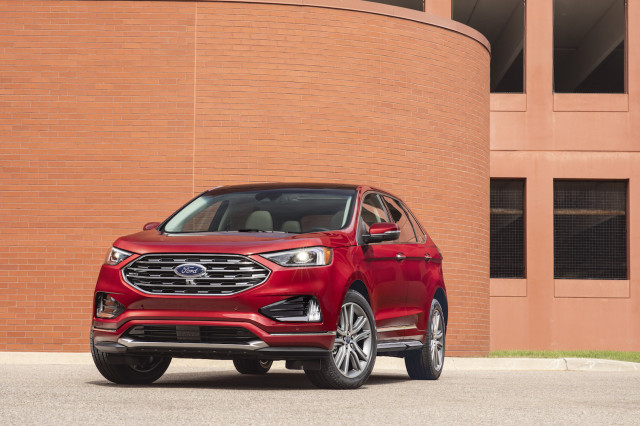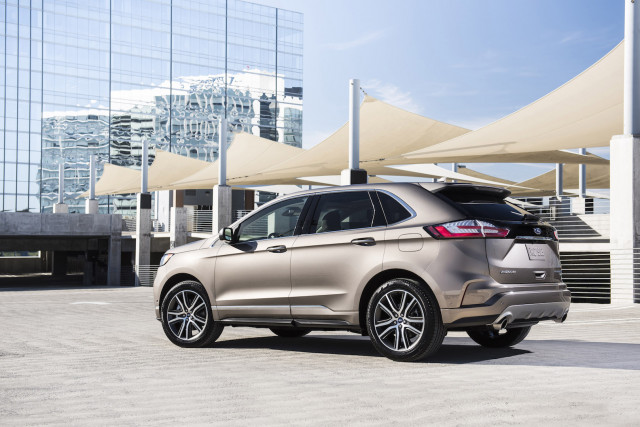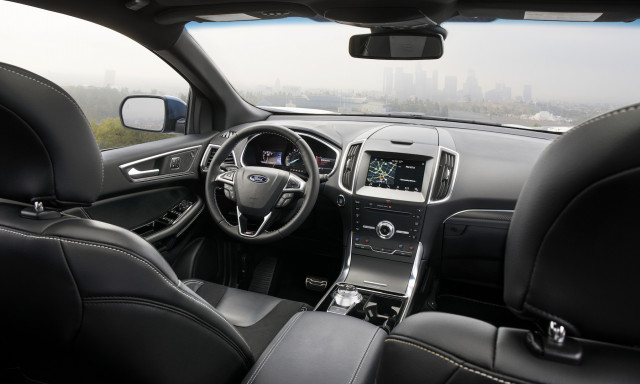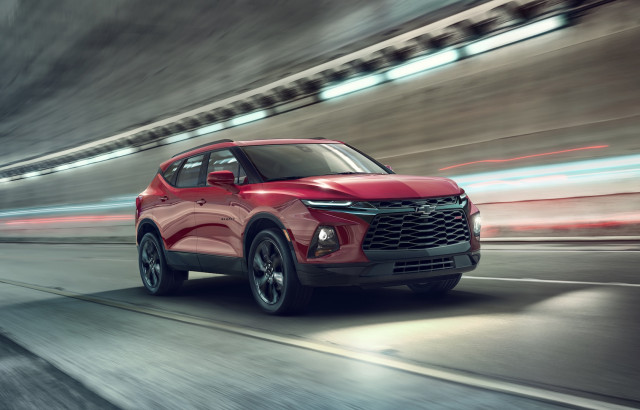2019 Ford Edge
With crossover SUVs like the 2019 Chevrolet Blazer and 2019 Ford Edge, their makers cater to shoppers who want a high seating position and a flexible, spacious interior, but not three rows of seats.
In updating its 2019 Edge, Ford takes on the revived Chevy Blazer. Unlike past Blazer SUVs that were off-road-ready, the latest model is a pavement pounder with a car-like suspension and a choice of front- or all-wheel drive.
We rate the 2019 Edge at 6.7 and the 2019 Blazer at 6.2, but the Chevy’s score could rise once it’s crash tested.
The Blazer’s racy, Camaro-inspired look is backed by a 308-horsepower V-6 teamed to a 9-speed automatic transmission in most configurations, although a 193-hp inline-4 comes standard on base L and 1LT trims.
2019 Ford Edge
2019 Ford Edge
2019 Ford Edge ST
Most Ford Edges leave the automaker’s assembly plant with a 250-hp 2.0-liter turbo-4 paired to an 8-speed automatic transmission, although the Edge ST features a turbocharged V-6 rated at 335 hp.
The Blazer weighs a little less than the Edge and has more power, so it’s no surprise that the Chevy performs better on the road. The Edge can run out of steam during high-speed passing. Both crossover SUVs handle well, with nicely weighted steering and comfortable ride quality. Larger wheels on higher-trim versions of both ride stiffer, but not uncomfortably so.
Fuel economy tips in the Edge’s favor. With all-wheel drive, the turbo-4 Edge is rated at 23 mpg combined and the V-6-powered Blazer comes in at 21 mpg. Both crossover SUVs run on regular unleaded fuel.
The Blazer stretches 2.6 inches longer than the Edge and it’s less than half an inch wider. That bigger footprint doesn’t translate into a more spacious interior, however. The Edge has marginally more leg room for front- and rear-seat passengers and its cargo area is much more spacious. With the second row folded down, the Edge can swallow a maximum of 73.4 cubic feet of cargo while the Blazer can handle just 64.2 cubes.
We rate the front seats about the same on both crossover SUVs. Neither is tops in terms of comfort, but versions with power-adjustable and leather-upholstered seats provide better support. Rear-seat riders will find decent leg room in both and the Blazer’s bench moves fore and aft to open up more leg or more cargo room.
2019 Chevrolet Blazer
2019 Chevrolet Blazer
2019 Chevrolet Blazer
2019 Ford Edge and 2019 Chevrolet Blazer features and safety
The Blazer’s stylish dashboard matches its exterior and its standard 8.0-inch touchscreen for infotainment with Apple CarPlay and Android Auto compatibility easily trumps the 4.2-inch display that’s standard on the Edge SE trim level. Upgrading to the Edge SEL nets a similarly sized screen, but that trim level costs about $3,300 more. The Blazer’s infotainment software is easy to operate and includes a convenient sign-in feature that stores certain driver-specific vehicle settings such as radio presets and memory seat positions in the cloud. The optional system on the Edge has a clean interface and lets drivers use Waze over Bluetooth.
With typical options such as leather seats, branded audio, and all-wheel drive, the Edge Titanium and Blazer LT both cost about $42,000.
No crash-test data is available yet for the Blazer, but we’ll mark it down no matter what for lacking standard automatic emergency braking. Adding life-saving collision-avoidance tech means optioning up a Blazer to around $50,000. That’s outrageous considering not only is automatic emergency braking standard on the Edge, automakers including Chevy have agreed to fit the tech to nearly every new car by 2021. The NHTSA rates the Edge at five stars overall, but it missed out on an IIHS Top Safety Pick award due to subpar headlights.
Because of the Blazer’s surprising automatic emergency braking upcharge, the version we recommend costs about $10,000 more than a nicely equipped Edge. Whether the Blazer’s retro name and its futuristic style are worth that is up to you and your pocketbook.
Summary
Styling
Performance
Comfort & Quality
Safety
Features
Fuel Economy
MSRP
Invoice
Fuel Economy – Combined City and Highway
Engine
Drivetrain
Source: Read Full Article










